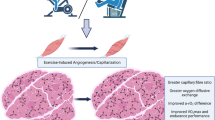Summary
Glucose metabolites (lactate, pyruvate, citrate, malate), alanine, glutamate and adenosine triphosphate (ATP) were determined in the resting anterior tibial muscle of dogs. The muscle was sampled in anesthetized animals first breathing air, and secondly after an hour of breathing a hypercapnic mixture, FICO2=0.10 (experimental subjects n=6) or air (control subjects n=6). A decrease in concentration of glucose metabolites (lactate: −34%; pyruvate: −24%; Citrate: −34%; malate: −54%), glutamate (−43%), alanine (−35%) and ATP (−8%) was observed in the resting muscle during acute hypercapnic acidosis. This was not the case in control animals breathing air.
Similar content being viewed by others
References
Barclay JK, Boulianne CM, Wilson BA, Tiffin SJ (1979) Interaction of hyperoxia and blood flow during fatigue of canine skeletal muscle in situ. J Appl Physiol: Respirat Environ Exercise Physiol 47:1018–1024
Bergmeyer HU, ed (1974) Methods of enzymatic analysis. 2nd English Edition. Verlag Chemie, Academic Press, New York, 4 volumes
Ehrsam RE, Heigenhauser GJF, Jones NL (1982) Effect of respiratory acidosis on metabolism in exercise. J Appl Physiol: Respirat Environ Exercise Physiol 53:63–69
Fabiato A, Fabiato F (1978) Effects of pH on the myofilaments and the sarcoplasmic reticulum of skinned cells from cardiac and skeletal muscles. J Physiol (Lond), 276:233–255
Folbergrova J, Macmillan V, Siesjo BK (1972a) The effect of moderate and marked hypercapnia upon the energy state and upon the cytoplasmic NADH/NAD ratio of the rat brain. J Neurochem 19:2497–2505
Folbergrova J, Macmillan V, Siesjo BK (1972b) The effect of hypercapnic acidosis upon some glycolytic and Krebs cycle-associated intermediates in the rat brain. J Neurochem 19:2507–2517
Gimenez M, Florentz M (1979) Effects of hypercapnia on the glycolytic metabolism, enzyme activity and myoglobin of stimulated skeletal muscle in the rat. Bull Eur Physiopathol Resp 15:269–284
Graham T, Wilson BA, Sample M, Van Dijk J, Bonen A (1980) The effects of hypercapnia on metabolic responses to progressive exhaustive work. Med Sci Sports Exerc 12:278–284
Graham TE, Wilson BA, Sample M, Van Dijk J, Goslin B (1982) The effects of hypercapnia on the metabolic response to steady-state exercise. Med Sci Sports Exerc 14:286–291
Hartemann D, Horsky P, Garcia Carmona T, Hannhart B, Saunier C (1976) Intermédiaires de la glycolyse érythrocytaire au cours d'une hypercapnie de trois jours chez le chien. Bull Eur Physiopathol Resp 12:185–197
Jacey MJ, Schaefer KE (1972) The effects of chronic hyper-capnia on blood phosphofructokinase activity and the adenine nucleotide system. Respirat Physiol 16:267–272
Jennings DB, Meyer M, Stokke T, Piiper J, Scheid P (1982) Blood-gas CO2 equilibration in lungs of unanesthetized dogs during hypercapnia. J Appl Physiol: Respirat Environ Exercise Physiol 52:1177–1180
Karetzky MS, Cain SM (1970) Effect of carbon dioxide on oxygen uptake during hyperventilation in normal man. J Appl Physiol 28:8–12
Kety SS, Schmidt CF (1948) Effect of altered arterial tensions of CO2 and O2 cerebral blood flow and cerebral O2 consumption of normal young men. J Clin Invest 27:484–492
Minakami S, Saito T, Suzuki C, Yoshikawa H (1964) The hydrogen ion concentration and erythrocyte glycolysis. Biochem Biophys Res Comm 17:748–751
Murray JF (1959) Oxygen cost of voluntary hyperventilation. J Appl Physiol 14:187–190
Pepelko WE, Dixon GA (1974) Elimination of cold-induced nonshivering thermogenesis by hypercapnia. Am J Physiol 227:264–267
Rastegar H, Wood M, Harken AH (1979) Respiratory alkalosis increases tissue oxygen demand. J Surg Res 26:687–692
Rizzo A, Gimenez M, Horsky P, Saunier C (1976) Influence d'une atmosphère de CO2 à 4% sur le comportement métabolique à l'exercice d'hommes jeunes. Bull Eur Physiopathol Resp 12:209–219
Saunier C, Schibi M, Colas T (1965) Hypercapnie aiguË expérimentale chez le chien; variations précoces de l'ion lactate dans le plasma artériel et le liquide céphalo-rachidien. C R Soc Biol 159:2235–2239
Schindler U, GÄrtner E, Betz E (1973) Energy-rich metabolites and EEG in hypoxia and in hypercapnia. In: Bicher HI, Bruley DF (eds) Oxygen transport to tissue, Advances in experim Med Biol, vol 37A. Plenum Press, New York, pp 233–238
Severinghaus JW (1966) Blood gas calculator. J Appl Physiol 21:1108–1116
Somjen G (1967) Effects of anaesthetics on spinal cord of mammals. Anesthesiology 28:135–142
Stupfel M (1960) Action du gaz carbonique sur la thermorégulation du rat blanc. I. Effets de de différentes concentrations de CO2 à diverses températures. J Physiol (Paris) 52:575–606
Weissman ML, Rubinstein EH, Sonnenschein RR (1976) Vascular response to short-term systemic hypoxia, hypercapnia, and asphyxia in the cat. Am J Physiol 230:595–601
Williamson JR, Corkey BE (1969) Assays of intermediates of the citric acid cycle and related compounds by fluoremetric enzyme methods. In: Lowenstein JM (ed) Methods in enzymology, vol XIII. Citric Acid Cycle Acad Press, New York, pp 434–513 (pp 471−473)
Author information
Authors and Affiliations
Rights and permissions
About this article
Cite this article
Saunier, C., Florentz, M. & Hartemann, D. Resting muscle glucose metabolites and related compounds in hypercapnia. Europ. J. Appl. Physiol. 55, 9–13 (1986). https://doi.org/10.1007/BF00422885
Accepted:
Issue Date:
DOI: https://doi.org/10.1007/BF00422885




